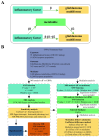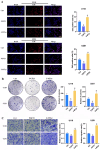Genetically Predicted 3-Methoxytyrosine Mediates the Causal Association between Fibroblast Growth Factor 21 and Glioblastoma Multiforme
- PMID: 39744501
- PMCID: PMC11685686
- DOI: 10.7150/jca.98035
Genetically Predicted 3-Methoxytyrosine Mediates the Causal Association between Fibroblast Growth Factor 21 and Glioblastoma Multiforme
Abstract
Background: Glioblastoma multiforme (GBM) is one of the most common brain malignancies characterized by an inflammatory microenvironment and metabolic reprogramming. This study aims to investigate the causal relationship between inflammatory factors (IFs) and GBM, as well as the potential mediating effects of specific plasma metabolites. Methods: We used a bidirectional two-sample Mendelian randomization (MR) approach to investigate the causal associations between 91 IFs and GBM. We employed a two-step MR technique to identify significant mediators in this relationship, followed by a mediation analysis to explore and quantify the mediating effects of specific metabolites on the causal relationship between IFs and GBM. In vitro experiments were conducted to verify the effects of specific IF and metabolite on GBM cells. The response of cells to treatment was examined using a series of assays, including colony formation, cell proliferation, and migration assays. Results: Three IFs showed significant associations with GBM. Among them, fibroblast growth factor 21 (FGF21) had a protective effect against GBM [odds ratio (OR): 0.42; 95% confidence interval (CI): 0.25, 0.71; p=1.00×10-3]. There was no strong evidence that genetically predicted GBM had an effect on FGF21 (OR: 1.04; 95% CI: 0.83, 1.31; p = 0.692). Mediation analysis identified 3-methoxytyrosine (3-MTyr) level (mediation effect of 11.50%) as a significant intermediary. The in vitro study demonstrated that FGF21 inhibited proliferation and migration in GBM cells, whereas 3-MTyr exerted the opposite effects. Conclusion: FGF21 was causally associated with a reduced risk of GBM, and this relationship is partially mediated by 3-MTyr. This identified regulatory network offers a novel avenue for further research into the pathogenic mechanisms of GBM and provides a theoretical foundation for the development of relevant therapeutic regimens.
Keywords: 3-methoxytyrosine; fibroblast growth factor 21; glioblastoma multiforme; mediation analysis; mendelian randomization.
© The author(s).
Conflict of interest statement
Competing Interests: The authors have declared that no competing interest exists.
Figures




Similar articles
-
Role of FGF21 in mediating the effect of phosphatidylcholine on GBM.Front Oncol. 2024 Sep 2;14:1428025. doi: 10.3389/fonc.2024.1428025. eCollection 2024. Front Oncol. 2024. PMID: 39286013 Free PMC article.
-
Dissecting causal relationships between gut microbiota, blood metabolites, and glioblastoma multiforme: a two-sample Mendelian randomization study.Front Microbiol. 2024 Jul 3;15:1403316. doi: 10.3389/fmicb.2024.1403316. eCollection 2024. Front Microbiol. 2024. PMID: 39021629 Free PMC article.
-
Causal associations between sleep traits, sleep disorders, and glioblastoma: a two-sample bidirectional Mendelian randomization study.J Neurophysiol. 2025 Feb 1;133(2):513-521. doi: 10.1152/jn.00338.2024. Epub 2024 Dec 31. J Neurophysiol. 2025. PMID: 39740798
-
Deciphering the causal relationship between plasma and cerebrospinal fluid metabolites and glioblastoma multiforme: a Mendelian Randomization study.Aging (Albany NY). 2024 May 10;16(9):8306-8319. doi: 10.18632/aging.205818. Epub 2024 May 10. Aging (Albany NY). 2024. PMID: 38742944 Free PMC article.
-
Plasma proteins, circulating metabolites mediate causal inference studies on the effect of gut bacteria on the risk of osteoporosis development.Ageing Res Rev. 2024 Nov;101:102479. doi: 10.1016/j.arr.2024.102479. Epub 2024 Aug 28. Ageing Res Rev. 2024. PMID: 39214170 Review.
References
-
- Chen J, Liu G, Wang X, Hong H, Li T, Li L. et al. Glioblastoma stem cell-specific histamine secretion drives pro-angiogenic tumor microenvironment remodeling. Cell Stem Cell. 2022;29:1531–46. e7. - PubMed
-
- Wang J, Tang W, Yang M, Yin Y, Li H, Hu F. et al. Inflammatory tumor microenvironment responsive neutrophil exosomes-based drug delivery system for targeted glioma therapy. Biomaterials. 2021;273:120784. - PubMed
LinkOut - more resources
Full Text Sources
Miscellaneous

